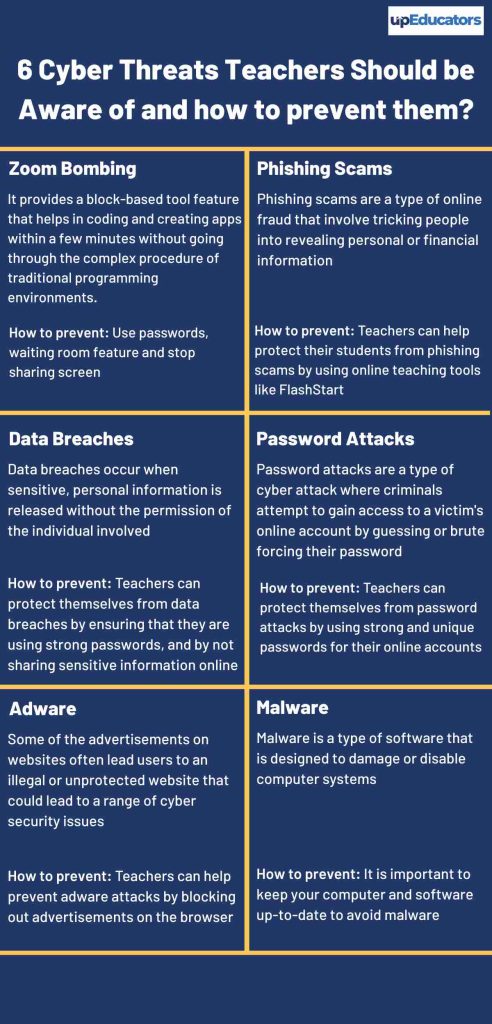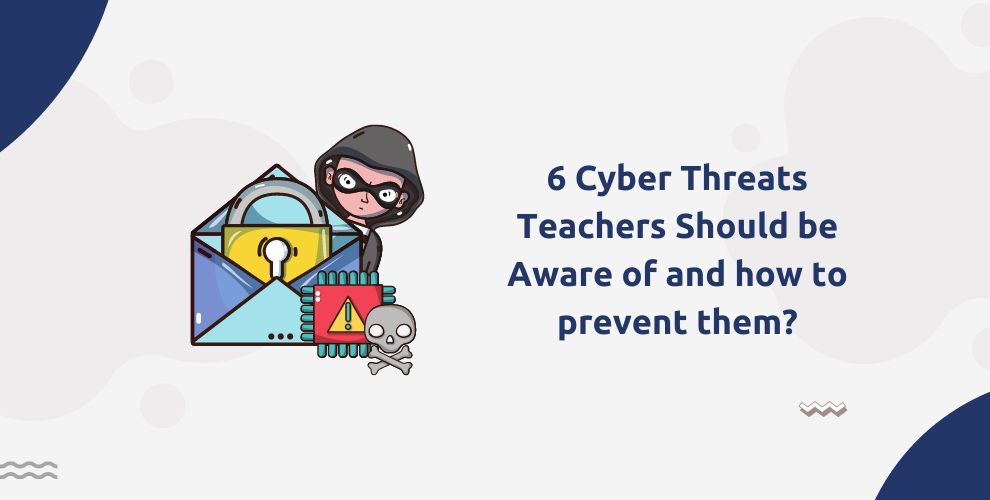Since the outbreak of the pandemic, the online education sector has become the target of increasing cyber-attacks. Students and teachers became easy targets for such attackers. Millions of users using online learning have received phishing emails that look legitimate. These emails contain links that lead users to unprotected spam sites. Users thus unknowingly invite all forms of cyber threats risking their data and privacy.
Cyber threats are dangers that exist online that can jeopardize the safety of your computer, your data, or your identity. There are many different types of cyber threats, and they can come from a variety of sources, including viruses, spyware, phishing scams, and more. While some cyber threats are more severe than others, all of them have the potential to cause serious harm to your online presence. That’s why it’s important to be aware of the different types of cyber threats and how to protect yourself from them.

Why Do Teachers Need to be Aware of these Cyber Threats?
According to a report by Corriere Comunicazioni, Cyber Threats increased by 47% in 2021. A primary target of these cyber attackers were online teachers and learners. There are many reasons why teachers need to be aware of the potential cyber threats that they face.
- Firstly, the increasing use of technology in the classroom means that teachers are increasingly reliant on technology to deliver their lessons. This makes them more vulnerable to attack if their systems are compromised.
- Secondly, as more and more educational institutions move towards online learning, teachers need to be aware of the risks associated with sharing sensitive information online.
- Finally, with the increasing use of social media, teachers need to be aware of the potential for their personal information to be accessed and used without their consent. By being aware of these threats, teachers can take steps to protect themselves and their students.
Zoom Bombing
Zoom bombing refers to the act of crashing or interrupting a Zoom meeting by someone who is not a part of the meeting. This can be done by anyone with the link to the meeting and is often done for harassment or disruption.
How to Prevent:
There are a few things that teachers can do to prevent zoom bombing in their classes. First, they can require a password for all meetings. This will ensure that only those with the password can join the forum. Second, they can enable the waiting room feature, which will allow them to screen participants before admitting them to the meeting. Finally, they can disable the screen-sharing function, which will prevent zoom bombers from being able to share disruptive or offensive content with the rest of the participants.
Phishing Scams
Phishing scams are a type of online fraud that involve tricking people into revealing personal or financial information. They typically involve fake emails or websites that appear to be from a legitimate source but are designed to steal your information.
How to Prevent:
Teachers can help protect their students from phishing scams by using online teaching tools like FlashStart that allow them to verify the authenticity of websites and email addresses. They can also teach their students to be aware of these scams and how to avoid them.
Data Breaches
Data breaches occur when sensitive, personal information is released without the permission of the individual involved. This can happen when hackers gain access to a database of information, or when an organization fails to properly secure its data.
How to Prevent:
Teachers can protect themselves from data breaches by ensuring that they are using strong passwords, and by not sharing sensitive information online. They can also keep their personal information private by limiting the amount of information they share on social media.
Password Attacks
Password attacks are a type of cyber attack where criminals attempt to gain access to a victim’s online account by guessing or brute forcing their password. This can be done by guessing common passwords, using a dictionary of words, or by using a tool that generates random passwords.
How to Prevent:
Teachers can protect themselves from password attacks by using strong and unique passwords for their online accounts. They should also avoid using the same password for multiple accounts, and enable two-factor authentication whenever possible.
How to Save Yourself
Adware
All of us have been on the receiving end of unwanted advertisements. Every time a user opens a website, tens of thousands of advertisements keep popping up from every corner of the screen. Most of these advertisements often lead users to an illegal or unprotected website that could lead to a range of cyber security issues.
How to Prevent:
Teachers can help prevent adware attacks by blocking out advertisements on the browser. Some browsers provide the feature to block advertisements while for others, one needs to download third-party ad blockers.
Riskware
Sometimes, a user downloads files that harm the computer system and even affect our data and privacy. Riskware is such a kind of cyber threat when unknowingly a user downloads files that execute certain harmful actions on the device without the consent of the user.
How to Prevent:
One of the easiest ways to avoid riskware is to download files and access websites or applications using the official vendor. Sometimes users tend to download files, and applications and access websites using unofficial sites. This can lead to riskware attacks. Furthermore, users must always read the terms and conditions before accessing any website or platform.
Malware
Teachers
Malware is a type of software that is designed to damage or disable computer systems. It is a common form of cyber attack and can be difficult to prevent. However, there are some steps that teachers can take to help protect their computers from malware.
How to Prevent:
Firstly, it is important to keep your computer and software up-to-date. This means installing security updates and patches as soon as they are available. Secondly, you should use a reputable antivirus program and scan your computer regularly. Finally, be cautious about the emails and attachments you open, and only download files from trusted sources.
Cyber threats can drain people financially and in other different manners. Even teachers and students are not safe from different types of cyber threats and scams. Teachers thus need to first become aware of these threats and adopt ways to prevent them. And then every teacher needs to teach their students about these cyber threats and other aspects of digital citizenship. With awareness of these cyber threats, the online education sphere can become safe and secure.
Author: This article is written by Samiya Rashid for upEducators blog.




